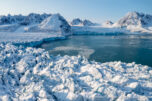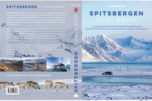-
current
recommendations- Liefdefjord
New page dedicated to one of Spitsbergen's most beautiful fjords. Background information and many photos.
- New Spitsbergen guidebook
The new edition of my Spitsbergen guidebook is out and available now!
- Liefdefjord
New page dedicated to one of Spitsbergen's most beautiful fjords. Background information and many photos.
Page Structure
-
Spitsbergen-News
- Select Month
- May 2025
- April 2025
- March 2025
- February 2025
- January 2025
- December 2024
- November 2024
- October 2024
- September 2024
- August 2024
- July 2024
- June 2024
- May 2024
- April 2024
- March 2024
- February 2024
- January 2024
- December 2023
- November 2023
- October 2023
- September 2023
- August 2023
- July 2023
- June 2023
- May 2023
- April 2023
- March 2023
- February 2023
- January 2023
- December 2022
- November 2022
- October 2022
- September 2022
- August 2022
- July 2022
- June 2022
- May 2022
- April 2022
- March 2022
- February 2022
- January 2022
- December 2021
- November 2021
- October 2021
- September 2021
- August 2021
- July 2021
- June 2021
- May 2021
- April 2021
- March 2021
- February 2021
- January 2021
- December 2020
- November 2020
- October 2020
- September 2020
- August 2020
- July 2020
- June 2020
- May 2020
- April 2020
- March 2020
- February 2020
- January 2020
- December 2019
- November 2019
- October 2019
- September 2019
- August 2019
- July 2019
- June 2019
- May 2019
- April 2019
- March 2019
- February 2019
- January 2019
- December 2018
- November 2018
- October 2018
- September 2018
- August 2018
- July 2018
- June 2018
- May 2018
- April 2018
- March 2018
- February 2018
- January 2018
- December 2017
- November 2017
- October 2017
- September 2017
- August 2017
- July 2017
- June 2017
- May 2017
- April 2017
- March 2017
- February 2017
- January 2017
- December 2016
- November 2016
- October 2016
- September 2016
- August 2016
- July 2016
- June 2016
- May 2016
- April 2016
- March 2016
- February 2016
- January 2016
- December 2015
- November 2015
- October 2015
- September 2015
- August 2015
- July 2015
- June 2015
- May 2015
- April 2015
- March 2015
- February 2015
- January 2015
- December 2014
- November 2014
- October 2014
- September 2014
- August 2014
- July 2014
- June 2014
- May 2014
- April 2014
- March 2014
- February 2014
- January 2014
- December 2013
- November 2013
- October 2013
- September 2013
- August 2013
- July 2013
- June 2013
- May 2013
- April 2013
- March 2013
- February 2013
- January 2013
- December 2012
- November 2012
- October 2012
- September 2012
- August 2012
- July 2012
- June 2012
- May 2012
- April 2012
- March 2012
- February 2012
- January 2012
- December 2011
- November 2011
- October 2011
- September 2011
- August 2011
- May 2011
- April 2011
- March 2011
- February 2011
- January 2011
- December 2010
- November 2010
- September 2010
- August 2010
- July 2010
- June 2010
- May 2010
- April 2010
- March 2010
- February 2010
- November 2009
- October 2009
- August 2009
- July 2009
- June 2009
- May 2009
- April 2009
- March 2009
- February 2009
- January 2009
- December 2008
- November 2008
- October 2008
- August 2008
- July 2008
- June 2008
- May 2008
- April 2008
- March 2008
- February 2008
- April 2000
- Select Month
-
weather information
-
Newsletter

| Guidebook: Spitsbergen-Svalbard |
Home →
Yearly Archives: 2019 − News
Spitsbergen under sail 2019 and Rolf’s arctic blog starting now
The arctic summer season “Spitsbergen under sail” is starting tomorrow (Saturday) with sV Antigua: we are starting our first departure in Longyearbyen – arctic spring/early summer. Exploring stunning landscapes, ice and snow and the arctic wildlife under sail!
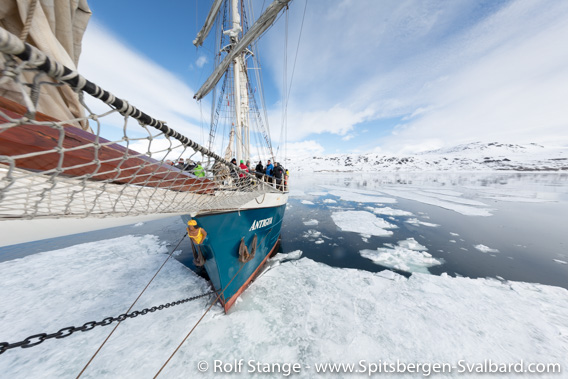
Spitsbergen under sail: with SV Antigua to the ice.
And this means of course that my arctic blog on exactly this page will be updated again regularly, and it is absolutely worth coming back and checking for new photos and short stories. Join us online when we explore remote arctic fjords and islands and meet the wildlife! We will explore Spitsbergen several times under sail with SV Antigua, but also with the smaller SY Arctica II and we will also venture to Greenland with the good SY Anne-Margaretha.
And if you want to join us in real life – the voyage descriptions for 2020 are now online! (German only, sorry, but that is the board language on these trips).
Polar bear close to Longyearbyen
A polar bear was seen close to Longyearbyen near 5 a.m. on Monday (27 May) morning. It was in Adventdalen, not far from the road and the lowermost houses. The Sysselmannen (police) was called, several shots were fired with a flare gun and the helicopter went out to scare the bear away from Longyearbyen. The bear then walked away along the shore towards Hiorthhamn, on the other side of Adventfjord.
The public is reminded to take the risk of meeting a polar bear seriously also near Longyearbyen.
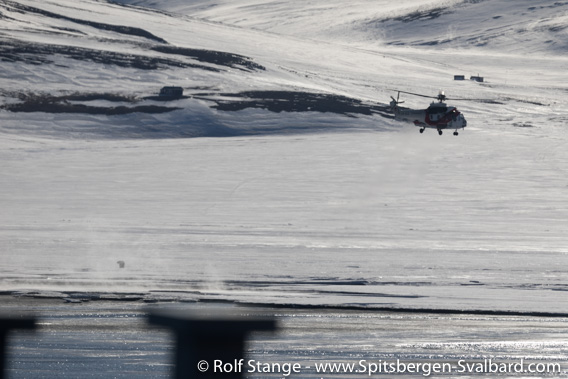
The Sysselmannen’s helicopter and the polar bear (lower left) in Adventdalen.
Housing market in Longyearbyen: avalanches and Airbnb
Housing market in Longyearbyen under pressure
The difficult housing market in Longyearbyen has been the subject on these pages already several times before. For years, it has been almost impossible to find an affordable place to live.
139 flats to be demolished
The situation got worse after the tragic 2015 avalanche, which killed 2 people in their homes and destroyed several houses. In the aftermath, a new avalanche risk evaluation was made for Longyearbyen. The shocking result is that houses with a total of no less than 139 flats have to be demolished, and avalanche barriers to secure remaining buildings are needed. A number of avalanche protections have already been built on the slopes of Sukkertoppen.
Further 41 fats at risk
Now doubts are coming up if it will actually be possible to secure some of the remaining buildings suffciently. The requirement is to build avalanche protection that is strong enough even for worst case scenarios of climate change – “business as usual” scenarios regarding future global CO2 emissions. In this case, foundations would have to go as deep down into the slope as 14 metres to make the barriers strong enough.
The question is if this is actually possible in the steep terrain. The answer is currently unclear. In the worst case, further houses with up to 41 homes will have to be removed, as reported by Svalbardposten. This concerns houses close to Sukkertoppen in Way 228.
Even though the result – demolition or not – is currently uncertain, one thing is for sure: the housing market in Longyearbyen will become even more difficult.
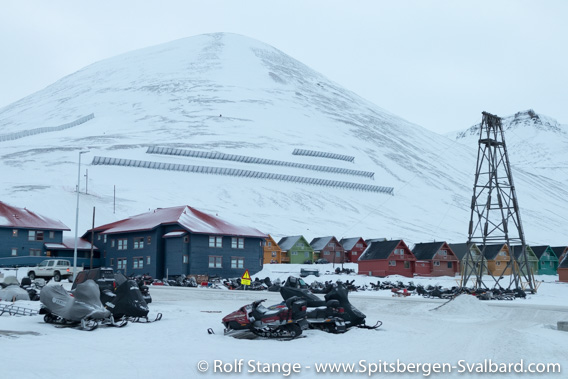
Residential houses, and avalanche barriers on Sukkertoppen.
Airbnb
Another factor which has caused public debate over years is the short-term rental platform AirbnB. It is no secret that a number of homes in Longyearbyen are rented out by their respective owners on short-term basis via Airbnb to tourists and not on long-term contracts to people who want to live in Longyearbyen. The actual number of homes that are lost this way for the housing market is not exactly known, but it is considered significant. When Svalbardposten recently researched the issue, 36 homes in Longyearbyen were offered on Airbnb.
More exact numbers are currently not available, so the community (Lokalstyre) has ordered a report from a specialised company to get more information about the influence of Airbnb on the local housing market. Depending on the result, the community could then consider limitations.
Airbnb is in the centre of public discussions linked to the housing market in many places in the world, but Longyearbyen may be more difficult than other towns: it is a small place with a small number of houses, where every loss makes a difference. There are many tourists with a lot of money, distorting the small and tight local housing market. Thirdly, you can not just move, settle down in the next village and commute.
One thing is for sure: it is currently almost impossible to find a home in Longyearben for smaller incomes.
Two persons dead in mountain accident in Hornsund
Two persons died during a mountain hike in Hornsund. They were a woman and a man who belonged to the crew of the Polish research station in Hornsund. They had set out for a private tour on Friday but did not return until the agreed time on Sunday morning, so the remaining station crew started a search.
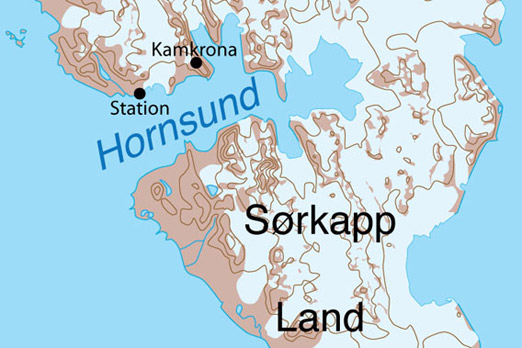
Map of Hornsund showing the research station and the mountain Kamkrona (accident site). © topographic base: Norwegian Polar Institute.
They had ascended the mountain Kamkrona, which is part of Sofiekammen, a long, steep ridge on the west side of Burgerbukta. Kamkrona is about 8 km east of the research station and 770 metres high, the east side of the mountain is very steep.

The mountain ridge Sofiekammen on the west side of Burgerbukta in Hornsund. Kamkrona is a peak approximately in the middle.
According to a press release by the Sysselmannen the two victims died during a fall of several hundred metres in an avalanche. No further details are public so far. The victims were recovered by SAR forces of the Sysselmannen and brought to Longyearbyen.
Update: According to Svalbardposten, Sysselmannen police officer Anders Haugerud told the Norwegian news agency NTB that the two appear to have stepped out on an overhanging snow bank on the mountain top. This was later confirmed.
As the families are informed, the names of the two deceased have been officially released. They were Anna Górska and Michal Sawicki. Both had been working at the station, Anna as meteorologist and Michal as geophysicist.
Spitsbergen website in Norwegian
This Spitsbergen website is now also online in Norwegian under the domain name www.spitsbergen-svalbard.no.
It is by far the largest and most comprehensive website dedicated exclusively to Spitsbergen – or rather: to Svalbard, because it covers the whole archipelago including the most remote corners. That is reflected by a large number of sub-sites covering all aspects of the geography, wildlife, and flora as well as the vast and still growing collection of polar panoramas where you can virtually travel all over Svalbard. News of international interest are included as well as a travel blog that covers all seasons and some insights into life in Longyearbyen … it’s all in there, in one website, with about 800 sub-pages and more than 1100 blog entries (per language!). I started working on the original German website www.spitzbergen.de in 2006 and the English version www.spitsbergen-svalbard.com followed soon.

This Spitsbergen website is now also online in Norwegian.
After Svalbard – Norge nærmest Nordpolen came out, it soon became clear that the website had to go the same way. This happend now after several months of intense work – now www.spitsbergen-svalbard.no is online. There are some English pages still hidden in there in a few places, their translation is still going on. Lucky if you find one 🙂
Big thanks to all who have helped to make this happen! This includes
Ida Elisabeth Aarvaag
Cecilie Bergheim
Marie Brekkhus
Mari Buck
Jannicke Høyem
Jesper Kirkhus
Tina Ottenheym
Aina Rogstad
Elisabeth Schoch
Veronika Sund
Ida Elisabeth Veldman
Ivar Våge
Tusen takk skal dere ha!
So for all Norwegian-speaking visitors to this website: enjoy reading and travelling Spitsbergen online in Norwegian on www.spitsbergen-svalbard.no!
Tundra swan near Longyearbyen
The swan song of the winter? Just in time for the “ornithological spring”, a rare tundra swan (Cygnus bewickii) showed up near Longyearbyen. Swans are not on the list of breeding birds in Spitsbergen, they come just occasionally as vagrants.
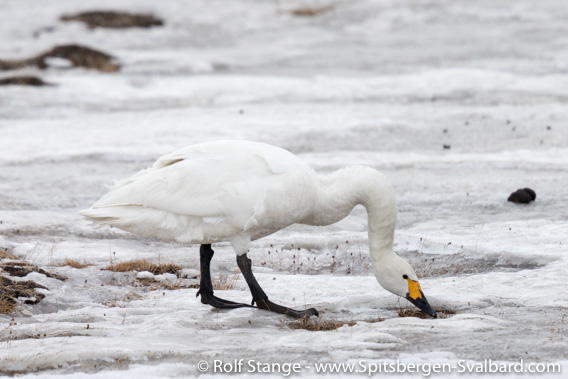
Tundra swan (Cygnus bewickii) in Adventdalen.
There are just five sightings of tundra swans registered on artsobservasjoner.no, a website to register species sightings in Norway. The oldest one of these observations is from 1987.
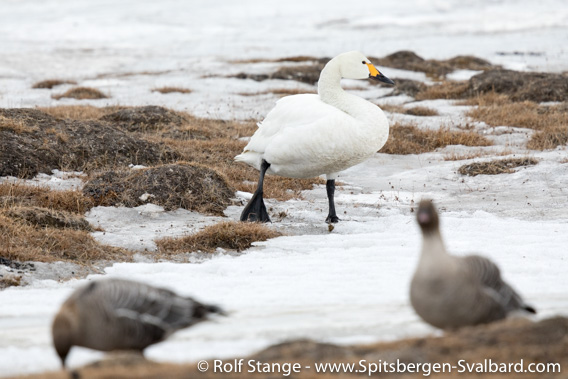
Tundra swan with pink-footed geese.
There are also sightings of the whooper swan (Cygnus cygnus) in Spitsbergen, 24 since 1992, including 7 observations from Bear Island (Bjørnøya). And regarding the tundra swan, things can actually be a bit confusing: according to Wikipedia, “The two taxa within it are usually regarded as conspecific, but are also sometimes … split into two species: Bewick’s swan (Cygnus bewickii) of the Palaearctic and the whistling swan (C. columbianus) proper of the Nearctic.”
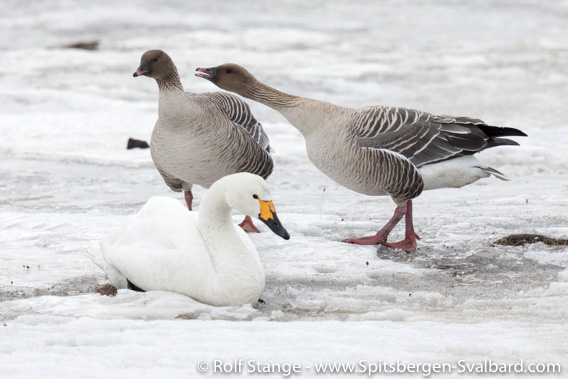
Tundra swan with pink-footed geese.
But in this case, local bird enthusiasts seem to have settled on a tundra swan (Cygnus bewickii). The bird seems currently quite happy amongst several dozens of pink-footed geese who came up during the last days after their spring migration.
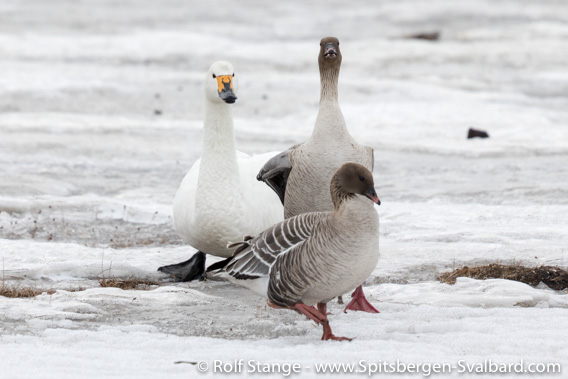
Tundra swan with pink-footed geese.
These photos were taken without disturbance with a focal length of 1200 mm and a high resolution camera.
Also these representatives of the local subspecies of reindeer seem to be happy that there are more and more patches of tundra coming through the snow now. The snow mobiles are stored away for this season, beast and man are looking forward to the summer now!
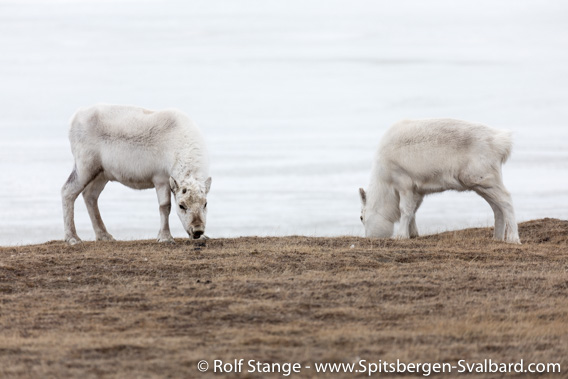
Reindeer on early snow-free tundra areas.
Bank robbery in Longyearbyen: verdict
Spitsbergen’s first bank robbery took place in Longyearbyen on 21 December 2018. The offender was a 29 years old Russian citizen who had come to Longyearbyen a few days before. He threatened the bank employees with a rifle and forced them to hand out 70,000 Norwegian kroner (ca. 7,000 Euro) with the words “This is not a joke. This is a robbery”.
The man was soon arrested by the police and taken into pre-trial custody in Tromsø. Now the court, Nord-Troms tingrett, sentenced him to 14 months prison, as NRK reported. In addition, he has to pay NOK 20,000.00 to each of the 3 bank employees whom he had threatened during the robbery.
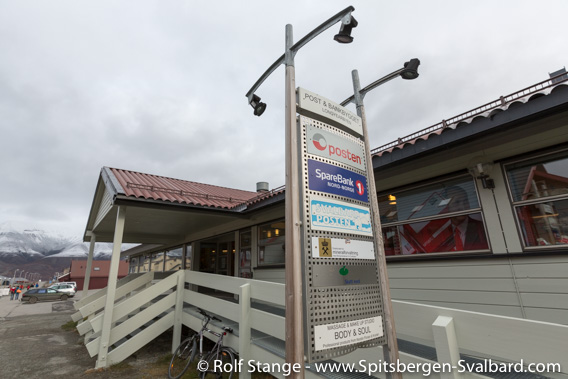
Bank robbery in Longyearbyen: offender sentenced.
Serious psychological problems are said to have played an important role. The man said that he had initially planned to commit suicide in Longyearbyen, but then decided to raid the bank in order to be arrested. It is also mentioned that he wanted to avoid having to return back to Russia.
The rifle that he had used during the bank robbery was loaded with sharp ammunition and the offender pointed it towards the bank employees. It was a bolt-action Mauser rifle, a very common type of rental weapon in Longyearbyen. After the robbery, the man went back to the rental shop with the rifle still loaded and returned the weapon. Then he went back to the bank to return the money, but did not succeed. Instead, he was soon arrested by the police. He did not offer reistance.
The sentence is below the claim of the public prosecuter, but higher than the defence lawyer had pleaded for. Revision is still possible.
Svalbard Skimarathon
Today (Saturday, 27 April) at 9 a.m., the starting shot for the Svalbard Skimarathon 2019 was fired by Sysselmann Kjerstin Askholt.

Sysselmann Kjerstin Askholt is ready to fire the starting shot for the Svalbard Skimarathon 2019.
The moment when the 2019 competition was a fact must have come as a bit of a relief for the organisers. The strong thawing during the week before Easter took a heavy toll on the snow conditions, and the route had to be moved on a short warning. Today’s Skimarathon takes the participants across Adventdalen and a short turn into Mälardalen, then along the coast of Adventfjord to Hiorthhamn and Advent City and finally into Hanaskogdalen and then back again.
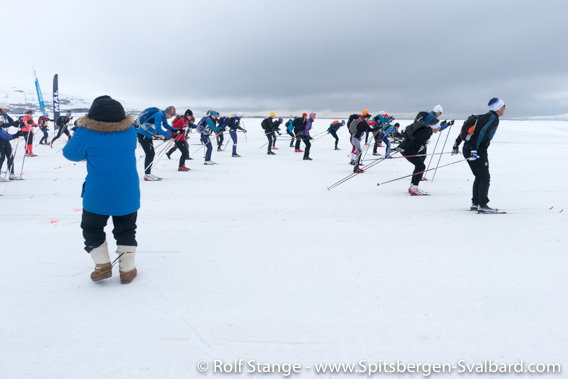
Start of the Svalbard Skimarathon 2019.
In addition comes the strike of the SAS pilots. Many had hoped that Longyearbyen would be excluded from the strike as there are no alternative means of getting here and away regularly available other than flying. Buses and trains are obviously not an option, in contrast to many cities in mainland Scandinavia. But the SAS flight Friday afternoon was cancelled and more cancellations are likely to follow.
How many registered participants were unable to fly to Longyearbyen is not known, but it is likely to be more than just a handfull. And a few days ago, the number of participants was already a bit lower than in 2018: about 800 in contrast to about 700. These figures are not final, as participants could register up to Friday evening, something that some locals always do, depending on their motivation status of the day and the weather forecast.
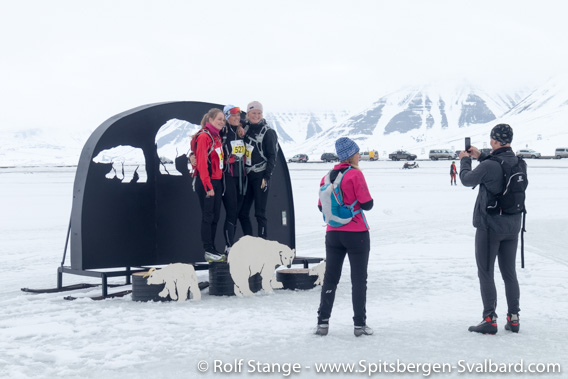
Pre-race award ceremony 🙂
Today’s Svalbard Skimarathon is the 27th one. It is one of the largest regular events in the calendar for Longyearbyen, attracting international participants from many countries.
A great day with much fun to all participants and all others involved!
Spitsbergen back to winter mode on Easter Sunday
After an early snow melting period last week, the winter returned to Spitsbergen exactly on Easter Sunday with temperatures below zero. After a couple of very wet and grey days, which frustrated tourists, locals, guides and tour operators alike, molten snow became ice – at least! – and the sun came out again.

Longyearbyen Camping: last week a lake, this week an ice area.
Longyearbyen Camping, last week an impressive landscape of lakes and lagoons, is now an ice area, with a surface just a bit too rough to provide a useful skating rink. Elsewhere, it is flat and shining as a mirror, something that does not make moving around easier, both in the field and in town. Spikes (isbrodder in Norwegian) can be very helpful and may prevent accidents.
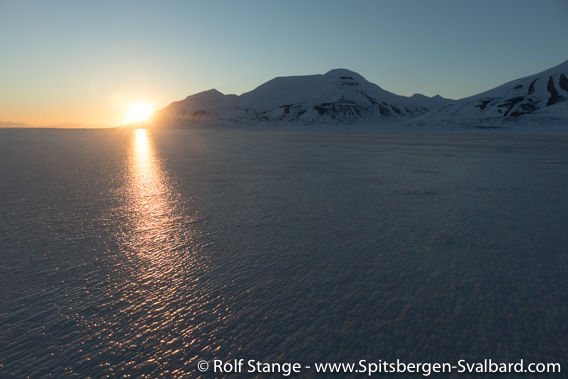
Adventdalen: last week a river, this week a skating rink.
Now it is good to be outside again!
And, yes: the Easter bunny also came all the way north to Spitsbergen. Happy Easter! 🙂
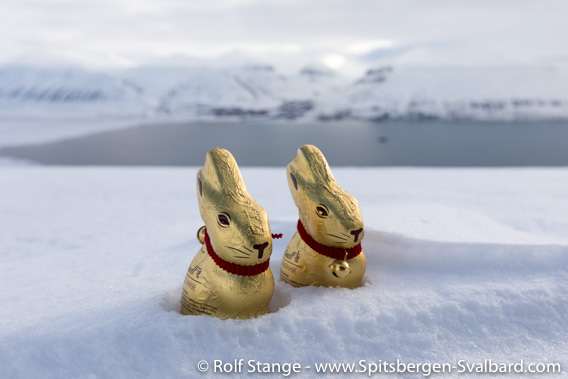
Happy Easter!
Spitsbergen is melting: early snow melt in Longyearbyen
Snow melt – 4 weeks too early
Yes, this is how the last entry started as well. It is not great. Yes, there have always been mild air incursions with thawing temperatures and rain in Spitsbergen, even in mid-winter. The climate here is maritime.
But a whole week? In April, a month that tends to be quite stable otherwise? That is quite tough.
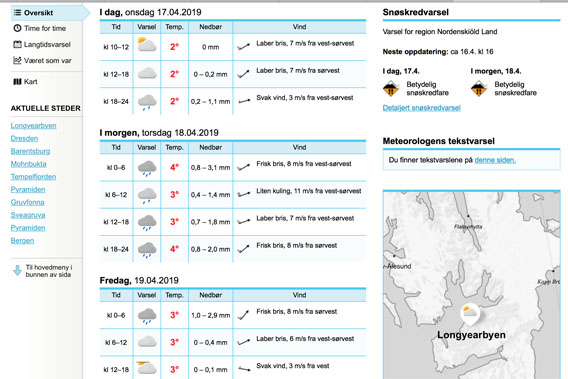
The weather forecast for Longyearbyen from last Wednesday
(© Norwegian Meteorological Institute).
This is what the weather forecast looked like on Wednesday. Temperatures in red, above zero, and rain. This is how it was pretty much all of the week, from Monday to Friday. Today (Saturday), there is some mild frost again, at least.
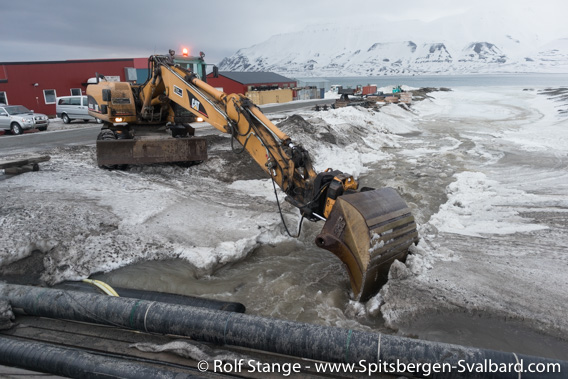
The riverbed of Longyearelva had to be opened to prevent flooding of the road.
Wherever you look, it is sad. It is melting and flowing everywhere. There are ponds and lakes instead of white snow surfaces, smaller rivers have started to flow again, tundra areas are coming through the wet snow.
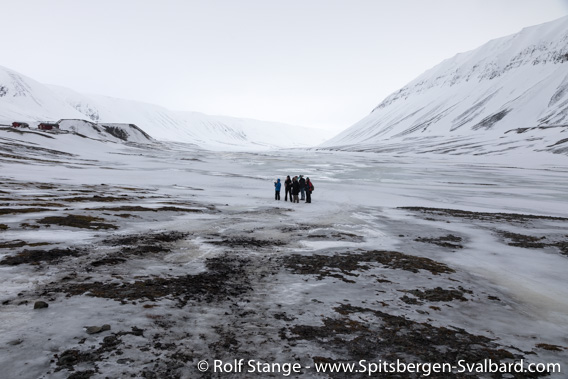
The Tundra is coming through the snow,
here in Bjørndalen in the beginning of this snow melt week.
They had to come with a digging machine to clear the river bed of Longyearelva, the river in Longyearbyen, from snow to prevent the road from being flooded. That is a normal procedure – but not in mid April (it was on Thursday).
The campsite is a lake. There was actually one lonely camper a week ago, but he left for some reason.
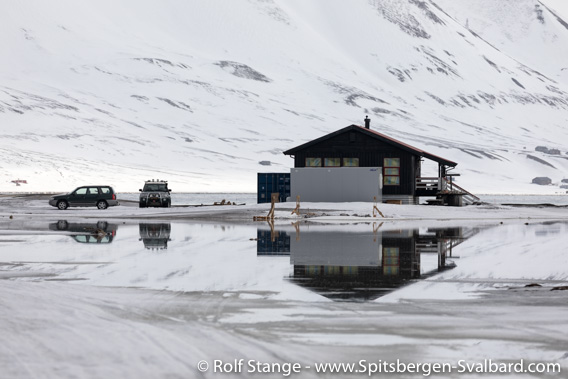
The campsite near Longyearbyen is a lake.
Easter weekend with question marks
The Easter weekend has begun, one of the main tourist seasons in Norway. Everybody is out and about, on tour somewhere, on holiday or visiting someone. Preferably something that has to do with a hut, snow and ski, alternatively a boat will also do.
A boat might actually be the better option than the kind of tour that you would expect in Spitsbergen at this time of year. White, wide snow landscapes, snow mobile trips to places far away or dog sledge tours and ski hikes somewhere around Longyearbyen.
But, alas, everything is grey and wet and water is flowing everywhere. The hotels are fully booked, planes come every day with easter tourists who have booked rooms and trips for stunning prices, looking forward to a taste of the real Arctic.
Right place, but wrong time.
Instead, mine 3, which is a museum mine now, is getting a lot of visitors. This is one of few places where you can book an interesting excursion right now regardless of the weather conditions, as long as the road is open. Not the kind of experience most would have thought of when they planned their trip, but certainly a very interesting experience.
Just for the sake of completeness: they are still running some snow mobile tours, obviously under rather marginal conditions.
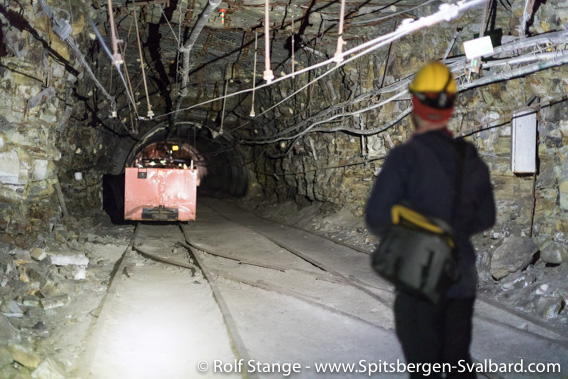
Visiting gruve 3, the visitor mine.
Today (Easter Saturday), there is some mild frost again, and temperatures are supposed to fall tomorrow. We will see if we get a bit more winter here again, or if the winter season is already over. That is a question many are considering in Longyearbyen now.
Midnight sun: next sunrise August
There is no “night” anymore in Longyearbyen. The last sunset was on Thursday, the midnight sun is shining since yesterday (Good Friday). The next sunset will be on 26 August – at 00.05 a.m., which means it is actually the 25 August, astronomically (because of daylight saving time, astronomical midnight is near 01 a.m.)
The ice cave in Longyearbreen
Snow melt – 4 weeks too early
Currently – today it is 18 April – I get the impression that Spitsbergen is really melting and flowing away. The snow melt has started, several weeks to early. This April will without any doubt be the 101st month in a row with temperatures above the long-term average.
But more about that later. One effect of the weather is that I have some time to write again now. It has been a while ago …
Ice cave – 4 weeks ago
… that we went to the ice cave in Longyearbreen. There are ice caves here in pretty much all glaciers, and the one close to Longyearbyen are popular places to visit, both by tourists with guides and by locals. You can dog-sledge or ski to the ice cave in Scott Turnerbreen in Bolterdalen, you can hike to the one on Larsbreen, also with snowshoes or on ski, and you can get to the one on Longyearbreen with a wider range of transportation means, here also including snow mobile or snow cat.

In the ice cave in Longyearbreen (mid March).
The ice caves are actually meltwater channels, but they usually fall dry during the winter season (meltwater flow may occur at any time of year, so be careful). Then they can be visited. Depending on the “terrain”, this can be easy or difficult. Some are so narrow and steep that visiting them may be impossible, at least for normal people, others are more visitor-friendly. In any case, an ice cave is a fascinating experience!
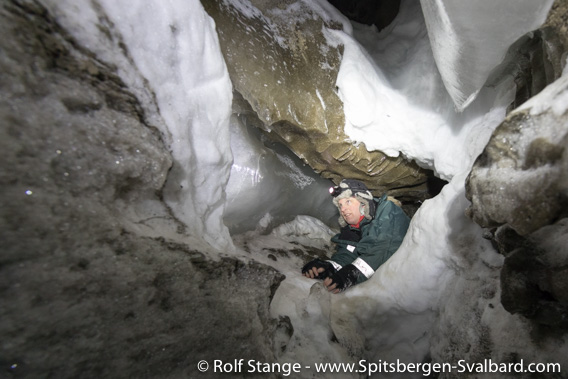
Ice cave in Longyearbreen.
Usually I don’t post too many pictures of myself, but I do like this one 🙂
Temperature in Longyearbyen since 100 months above average
Climate in Longyearbyen warmer than average since 100 months
February and March 2019 have mostly been cold months with temperatures around -20 degrees centigrade and below over many periods, but it has not been enough to reach the monthly average. Also in March, the average temperature of the months was above the long-term average. This was the 100th month in a row that the temperature (average of the month) was above the long-term average – more than 8 years, in other words, as climate scientist Kjetil Isaksen reports to Svalbardposten.
Reference period: 1960-1990
The reference period for the long-term average is 1960-1990. The normal temperature from this period is history: climate change is three times faster in Spitsbergen than in mainland Norway and six times faster than globally. According to Isaksen, this is largely due to increased water temperatures in the fjords and surrounding seas: there is more heat exchange between sea and atmosphere than before and the decreased ice cover enables the water to absorb sun radiation and turn it into heat rather than reflecting a higher proportion back into space as previously.
Avalanche barriers as an adaptation to climate change in Longyearbyen
Scientists do not expect this trend to stop at any time soon. In Longyearbyen, the community is adapting to a new climate.
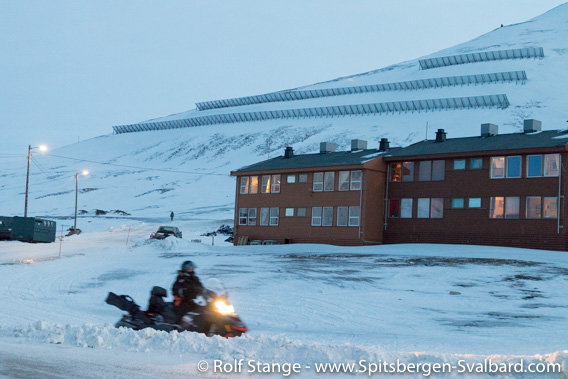
Avalanche barriers on Sukkertoppen close to Longyearbyen.
After the catastrophic avalanche from 19 December 2015 which has claimed two lives, hundreds of inhabitants are evacuated every year during the avalanche season, many of them for several months. Plans are currently made to tear down buildings with 142 flats in areas which are at risk from avalanches. Housing shortage and an overheated housing market are challenges that many locals in Longyearbyen currently have to deal with.
Barentsburg
Also in Barentsburg people are aware of these developments and an avalanche risk map has recently been published. Some buildings are in areas at risk and would not be built now where they are today. But it is assumed that the situation can be controlled technically, without moving or tearing down buildings.
Sysselmannen gives Store Norske permission to break ice in Van Mijenfjord
Store Norske Spitsbergen Kulkompani (SNSK), owner of the former coal mining settlement of Sveagruva, has got permission from the Sysselmannen to break the fjord ice in Van Mijenfjord to the harbour of Svea.
Van Mijenfjord is sheltered from the open sea by the island of Akseløya, which is almost blocking the entrance. Hence, the fjord is is settling earlier and getting more extensive there than in any other fjord on the west coast of Spitsbergen. The fjord ice in Van Mijenfjord is an important habitat which is not available anymore elsewhere as widely as earlier, due to the warming climate. Ringed seals need fjord ice in spring to rest and to give birth and polar bears frequent the ice to hunt.
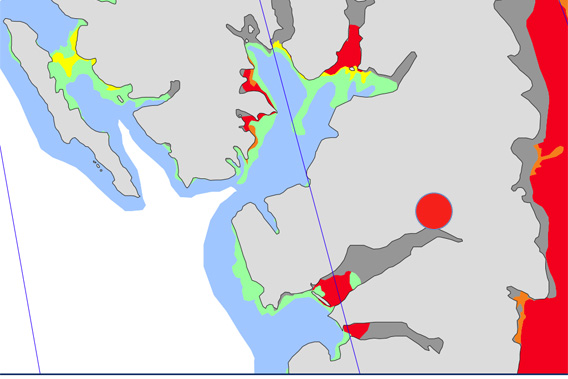
Ice chart: Van Mijenfjord is the only fjord in the region with a large area of solid ice. The fjord ice will be broken all the way to Sveagruva (red dot).
Chart © Norwegian meteorological Institute (dot added).
Usually, the authorities consider the fjord ice environmentally very important and will not give permission for ice breaking. Even non-destructive traffic with snow mobiles is now restricted: snow mobiles are not allowed anymore on large parts of the fjord ice in Tempelfjord, to avoid disturbance of wildlife which only occur in cases of reckless behaviour. Such traffic bans were also considered for Rindersbukta which is part of Van Mijenfjord, but not (yet) implemented.
Other rules seem to apply for breaking the ice, or at least the same rules are given a different interpretation. The Sysselmannen emphasizes in a press release that traffic in Spitsbergen is supposed to happen in a way that does not harm the environment or disturbs animals or people unnecessarily. But in this case, the economical interests of Store Norske were given more weight than the protection of the wildlife that needs the ice in times when it has become rare in Spitsbergen.
The background: Sveagruva is running out of diesel. Stocks were supposed to last until summer 2019, but consumption during the winter was higher than expected. Diesel is not just used for vehicles, but also to run the power plant in Svea, which is supplying the settlement with electricity and warmth. The current stock would now last “probably until May, approximately”, according to the Sysselmannen’s press release. And not until the summer, when the fjord ice would be gone anyway.
Without diesel for the power station, Svea would have to be evacuated. The consequence would not only be a temporary stop of the clean-up that has recently begun, but possibly also damage to the infrastructure. This would involve serious economical consequences for Store Norske. This is the reason why the company has got permission to break the ice and take a ship to Kapp Amsterdam, the harbour of Sveagruva. Technically, an overland transport from Longyearbyen would be possible, but this would involve approximately 60 tours. The total strain on the environment and the risk of pollution is considered higher and hence transport by ship was given priority.

The harbour of Sveagruva at Kapp Amsterdam.
In earlier times, when Sveagruva was still an active mining settlement, it was not unusual to break the ice in spring to ship coal. But times are different now. No coal is mined anymore in Sveagruva, and there is much less ice in the other fjords in Spitsbergen and this ice may not even be used for snow mobile traffic in certain fjords, opposed to the wishes and economical interests of many. It is not surprising that the permission to break more than 30 kilometres of solid fjord is is met with public criticism.
The weather in the days after breaking the ice will be important: if it remains cold and calm for a while, the fjord will quickly freeze again. But a storm might break up large areas of weakened ice.
Grounded trawler Northguider: recovery planned in August
The shrimp trawler Northguider ran aground in Hinlopenstrait close to Sparreneset on Nordaustland, just south of Murchisonfjord. The whole crew could be saved by helicopter, as reported earlier. The crew has later described the whole experience, in total darkness, strong cold and stormy wind, as very dramatic.
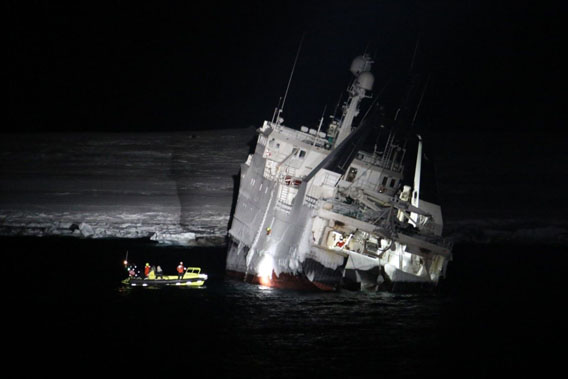
Fishing trawler Northguider grounded in Hinlopenstretet, close to the coast of Nordaustland. Photo: Kystverket.
300 tons of diesel and other environmentally dangerous substances and goods could be salvaged in January, but the Northguider is still sitting on rocks. Experts from Sjøfartsdirektoratet, the Norwegian shipping authority, judge her position as stable. The advantage of that is that forces of nature such as wind, currents and ice are unlikely to push the ship into deeper waters. The disadvantage is that also human efforts to salvage the grounded ship will require considerable efforts and a major operation. It is estimated that the salvaging operation will take several weeks of work on the scene.
The Sysselmannen, as the authority who is generally responsible for the management of the area in question, and the Sjøfartsdirektorat and the Kystvakt (coast guard) have now decided that the salvation work will be carried out in August. At that time, the general conditions regarding weather, ice and light should be most favourable.
The coast guard vessel KV Svalbard is currently on her way to the accident site to assess the situation there again, double-checking that there are no environmentally harmful substances and items are on board anymore and that the position of the Northguider is stable. Further monitoring is planned by motion detectors and beacons sendung the position of the ship in case of any unexpected movements.
Lunckefjellet: the end of an arctic coal mine
The Lunckefjellet coal mine is a political-economical phenomenon. The first ton of coal was “produced” in November 2013 – a symbolic act, the mine was not yet in productive operation. This was not the case either when Lunckefjellet was officially opened on 25 February 2014, but the mine was “ready to go”. Many thought production would start now big-time, as the mine had until then cost more than 1 billion Norwegian crowns (more than 100 million Euro) and it was there and ready to start production.
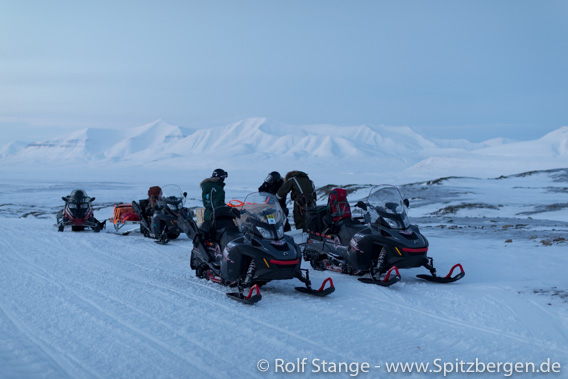
Scientists on the way to the Lunckefjellet coal mine.
But this was not to happen. The coal prices on the world markets dropped and the mines of Sveagruva, the Norwegian mining settlement in Van Mijenfjord, went into standby operation just to make sure they would not become inaccessible and mining could start one day – if this decisions was made.
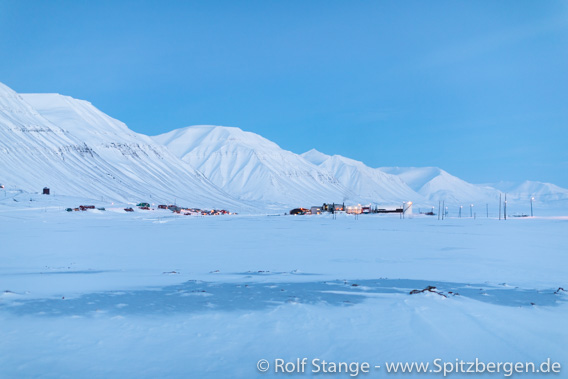
Sveagruva: Norwegian coal mining settlement (Swedish foundation in 1917) in Van Mijenfjord.
In the fall of 2017, the Norwegian government put their foot down. Being the 100 % owner of the Store Norske Spitsbergen Kulkompani (SNSK), the company that owns and runs all Norwegian coal mines in Spitsbergen, the government could directly decide about the fate of mining and miners in Sveagruva and Longyearbyen and related economies. The decision in 2017 was to put an end to all mining in Sveagruva. Both the coal mine Svea Nord, which had been profitable for a number of years, and the new mine in Lunckefjellet were to be phased out and physically cleaned up as far as possible. And the same was to happen for the settlement Sveagruva itself. Norwegian coal mining in Spitsbergen is only continued now in mine 7 near Longyearbyen (where the operation has since increase from one shift to two shifts).
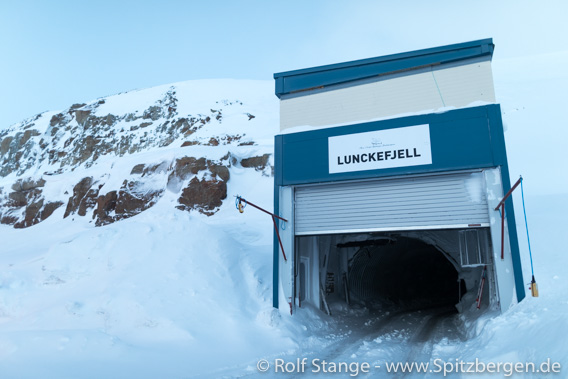
Day facilities and mine entrance at Lunckefjellet.
The reasons were officially said to be entirely economical considerations. The government does not really give more information than necessary, relevant documents have been declared confidential. Many see the end of coal mining in Sveagruva, especially in the newly built Lunckefjellet mine, with a tear in their eyes, as tradition, jobs and an industry that is important for Longyearbyen are about to get lost.
The end of coal mining in Spitsbergen does not come as a total surprise, everybody knew it would come one not too far day. Other branches are developed, with science, education and tourism high up on the list. Nevertheless, Longyearbyen would not exist without coal mining and mining has been the main activity here for most of the history so far. Many people have an emotional connection to mining and quite a few still have a real one, directly or indirectly, and losing coal mining will hurt them economically.
The government was not interested in discussing offers from investors to continue mining in Lunckefjellet, which was never intended to last for more than maybe 7-8 years anyway. This does not add to the credibility of the official reasoning for closing of the Lunckefjellet mine being solely based on the difficult economy.
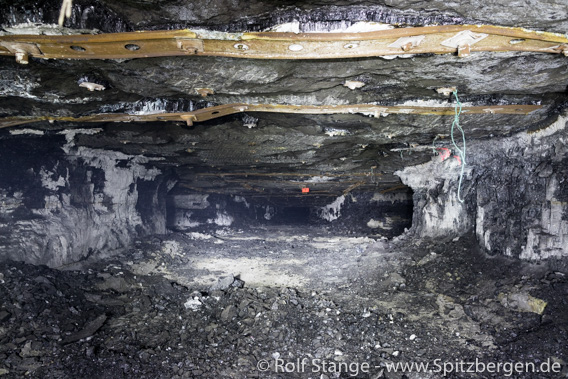
Tunnel of the coal mine in Lunckefjellet.
The coal mine in Lunckefjellet will be closed soon. The ventilation system is currently being dismantled, and once that is not operative anymore, only specialists with self-contained breathing apparatus could, theoretically, still enter the mine – for a short period, until the roof has become mechanically unstable. This will not take a lot of time. The Lunckefjellet mine will soon be as difficult to reach as the far side of the moon.
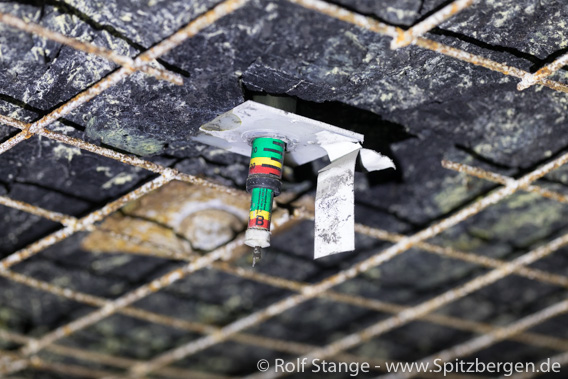
Device to monitor rock movements in the roof of the mine.

Bolts to secure the roof are exposed to permanent erosion and mechanical stress. If they are not regularly controlled and serviced a coal mine soon becomes a very dangerous place.
Last week (5-7 February 2019), geologists from the mining company Store Norske and UNIS took literally the last chance to take samples from the coal seam in Lunckefjellet. The coal geology in Spitsbergen is less well known than one might assume and than geologists would want it to by: nobody really knows what the landscape exactly looked like where the bogs grew that later formed the coal.
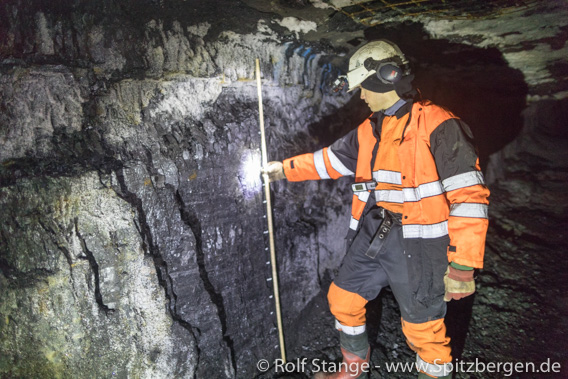
Geologist Malte Jochmann at work in Lunckefjellet.
Of course there were bogs, and saltwater from a nearby coast is likely to have been an important factor, at least at certain times. But which role did sweetwater play, lakes and rivers? Why are there sandstone and conglomerate (gravel-bearing sandstone) layers and channel fillings within and just on the edge of the coal seam? What did the sea level do at the nearby coast, what was the influence of tectonics? Were there hills or even mountains in the area, or was the surrounding relief more or less level?
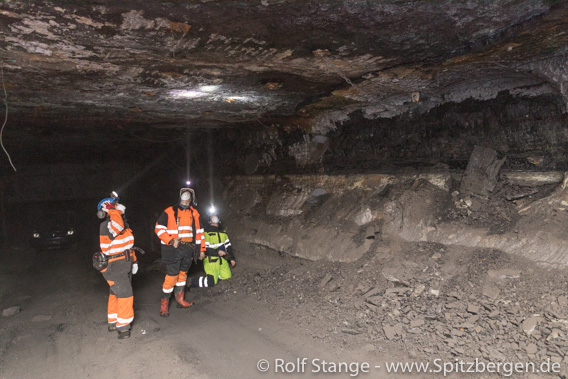
Geologists Malte Jochmann, Maria Jensen and Christopher Marshall at work in the Lunckefjellet mine, inspecting outcrops and potential sampling sites.
A walk through the tunnels of the Lunckefjellet mine produces fascinating views into the geological history, raising questions and answering some of them. The geologists Malte Jochmann (SNSK/UNIS), Maria Jensen (UNIS) and Christopher Marshall (University of Nottingham) had just two days to document outcrops and to take samples which might answer some of these questions in further, detailed investigations involving advanced laboratory methods.
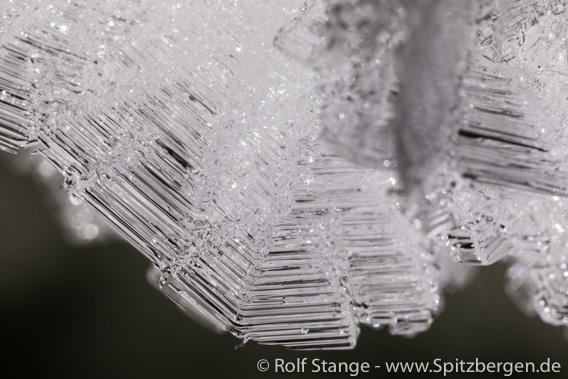
Even inside a mountain you are constantly reminded that you are in the Arctic: the temperature is constantly below zero, and ice crystals are growing on black coal surfaces.
Now the Lunckefjellet mine is about to be closed forever. A lot of equipment has already been removed, soon the mine can not be entered anymore. Also Sveagruva will be subject to a major clean-up, initial work has already begun. There won’t be much left in the end. Some artefacts which are considered having historical value will remain (everything older than 1946 is generally protected in Spitsbergen, the threshold will probably be moved up to 1949 in Sveagruva) and possibly a very few buildings for future use – research? Limited tourism? Nobody knows.
It will not be mining, that is for sure.
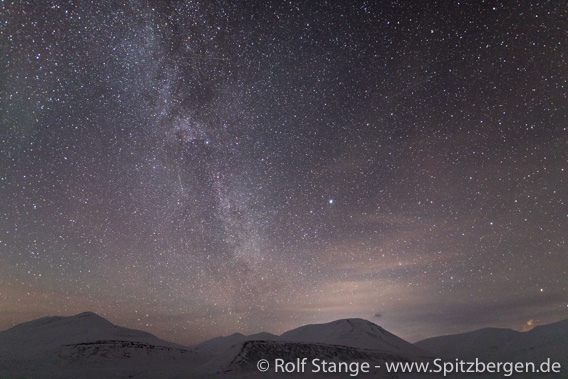
Sky of stars on the way back from Sveagruva to Longyearbyen.
News-Listing live generated at 2025/May/04 at 08:15:26 Uhr (GMT+1)
